Knife Sharpening
55 Experts Share Their Number One Knife Sharpening Tip
15.11.2014
Are you just starting out sharpening your knives and want some professional tips?
I asked 55 experts to share the best recommendation they would give to a beginner knife sharpener.
WHY DO AN EXPERT ROUNDUP?
It is historically proven that humanity as a whole tends to address questions more accurately when they pool their input together- A crowd of people collaborating on a problem is very often more effective than any individual response. In this case, we’ve 55 experts giving their opinion, based on their own experience. They’ve been sharpening knives professionally for years- who better than them can give you a valuable recommendation?
KNIFE SHARPENING TIPS FOR BEGINNERS – INFOGRAPHIC!
I’ve summarized what the majority of the experts told me. You can easily see the results here below. No matter what sharpening equipment you use, try to follow them!

Embed This Image On Your Site
THE EXPERTS
You can find all the opinions below.
[quote style=”boxed”]
WICKED EDGE USA – FACEBOOK
I guess my number one tip would be, no matter how you sharpen, to color in the bevels with a marker and carefully observe how the marker is coming off the bevels as you sharpen.
If possible, use magnification to observe the very edge. This tip works with freehand sharpening and with angle guided sharpeners.
[/quote]
[quote style=”boxed”]
NEW EDGE SHARPENING – FACEBOOK
Start your first sharpening lesson on a chef knife with a COARSE stone, 500-600 grit. (This is a relatively new thought process for me as I used to encourage starting with a 1,000 grit stone). However, the raising of that first Burr is a pivotal moment, it ignites your sharpening passion. The abrasive yet gently properties of a coarse stone on a knife held at the appropriate sharpening angle will produce a burr quickly, effectively and harmlessly. This sensation will elevate the motivation to sharpen properly, allowing this to occur quickly is beneficial and conducive to learning the technique. The key to Sharpeners Paradise is unlocked by the proper utilization of a coarse stone.
[/quote]
[quote style=”boxed”]
STEVE BOTTORFF
Scratch patterns and their importance in edge qualities.
Initial grinding should be made with the stone going off the edge, creating an “exit” burr. This burr is larger and will help you detect your new edge before you remove more material than necessary. Final honing should be done with the stone coming onto the edge. Alternate sides with each stroke to eliminate the burr. The remaining “entrance” burr is only as large as the abrasive particles, the smallest burr possible.
Scratches perpendicular to the edge leave the strongest “teeth” and work best for push cuts.. Experiment with scratch patterns of up to 45 degrees in either direction to see how they affect slicing cuts. Teeth that slant toward the tip aid forward slicing but I find I do most slicing pulling the knife back and like my teeth to slant toward the heel or bolster of the blade. Crock sticks and ceramic steels will automatically give this pattern.
Avoid pull through sharpeners. The scratch pattern parallel to the edge weakens it and causes small pieces to flake off.
Important: These comments only apply to hand sharpening with stones or rods. Stropping must be done off the edge to prevent cutting the soft strop material and all power sharpening should be done off the edge for safety.
[/quote]
[quote style=”boxed”]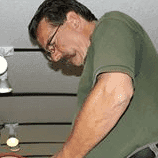
RICH’S SHARPENING SERVICE – FACEBOOK
Look at your work when done make sure you deburr.
[/quote]
[quote style=”boxed”]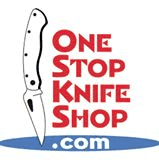
ONE STOP KNIFE SHOP – FACEBOOK
Use a sharpie to color the edge prior to sharpening. That way you can see what areas have been sharpened and what areas need to be hit. Use a quality sharpener like the spyderco sharp maker and it makes the task much easier
[/quote]
[quote style=”boxed”]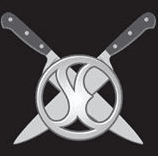
SEATTLE EDGE – FACEBOOK
To be honest, there isn’t one specific thing I would recommend, but a few key concepts to keep in mind when sharpening: movement isolation, consistency, inspection and patience.
Movement isolation is paramount when sharpening. Isolating movement within your own body will help you maintain a consistent angle, and a consistent angle yields a consistent bevel. For a knife to become sharp, each side of the blade must come together and meet in the middle (regardless of edge type, 50/50, 80/20 bevel etc). By isolating movement you will have the control needed to not only create your initial bevel, but to follow that bevel through out the sharpening process. Pay special attention to your wrists when sharpening, it is very easy to move your wrists out of alignment which creates an un-even bevel.
Consistency from pass to pass is also very important. Even if the angle you are using isn’t ideal, being consistent will allow you to maintain an even bevel which will let each side of the blade meet evenly at the edge. Being consistent will also help you modify your technique if need be.
Inspection is very important. I am constantly inspecting my work while sharpening. Regular inspection allows you to monitor your progress throughout the sharpening process, and make changes if you need to along the way. If you are using too high of an angle, inspecting while sharpening will allow you to identify that, and modify your technique accordingly.
Patience…. Perhaps the most important of all! Some knives take a looong time to reprofile. While more aggressive stones will help speed up the process, it’s the knife that decides how fast you will finish the project, not you. It is very easy to get frustrated and tired; when this happens, your technique and attention to detail decreases. This can often cause more harm than good. When you find your self getting tired/annoyed etc, take a break. Grab some lunch or just leave the project until tomorrow. In the long run, it’s worth it.
In review: movement isolation creates consistency. Consistency creates even bevels. Inspection allows you to monitor your work and make changes if need be. Patience – not only keeps you sane, but keeps your work clean by being consistent. Look at how Albert sharpens his knives here.
[/quote]
[quote style=”boxed”]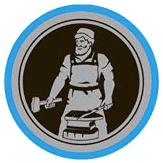
MESSER MEISTER – FACEBOOK
We recommend that you hone your knives on a weekly basis. This should keep your knives nice and sharp! If you can’t get your edge back by honing, sharpen it on either a ceramic or diamond coated steel or a stone. This will removes flaws and blemishes. Do note that every time you sharpen, not hone, your knife, you are removing steel making the life of your knife shorter. Honing a knife aligns the edge without removing steel. Try to only sharpen your knife when you absolutely have to. By following these guidelines, a good knife will last a lifetime.
[/quote]
[quote style=”boxed”]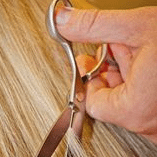
SHARPENING SERVICE UK – FACEBOOK
My tip for beginners would be to keep it simple.
Raise a burr somehow, and then strop it off on something like an old leather belt. Don’t view too many YouTube videos as they will raise doubt and over complicate a very simple process.
Aim for a 15 degree angle on Kitchen knives and 20 to 25 on hunting knives.
Don’t over strop.
[/quote]
[quote style=”boxed”]
CLIFF STAMP
Start by understanding what sharpening means, that is to say what is the physical change you are trying to make to the knife – the method will follow.
[/quote]
[quote style=”boxed”]
SHARPER EDGE HAWAII – FACEBOOK
Knowledge, equipment and knowing what a sharp edge is. Take your time, learn your basic angles.
[/quote]
[quote style=”boxed”]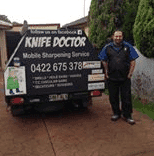
KNIFE DOCTOR
Get to know what you’re working with as everything you sharpen is different. I never recommend dry grind at all.
[/quote]
[quote style=”boxed”]
RAZOR EDGE KNIVES
The no.1 tip I would give would be to make sure you truly apex your edge.
[/quote]
[quote style=”boxed”]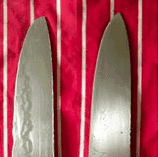
PHILIP JOHNSON KNIFE SHARPENING – FACEBOOK
Take metal off sparingly, it can’t be put back. Look and take stock first, then grind / polish, but always remove only the minimal amount of metal.
[/quote]
[quote style=”boxed”]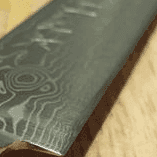
SAMURAI EDGE KNIFE SHARPENING
Do it slowly, with nice and steady hands. Keep looking after a few strokes making sure your angles you require are right.
[/quote]
[quote style=”boxed”]
INDEFINITELY WILD – FACEBOOK
My best advice is to make it easy for yourself by buying knives made from easy to sharpen steels. 1095 is very easy to work with and can be found on quality fixed blade knives. Note that it is a carbon steel which will discolor if you don’t take care of it or use it regularly. VG10 is, in my experience, the easiest to sharpen “super steel.” You’ll find that on nice folding knives, because it’s stainless.
[/quote]
[quote style=”boxed”]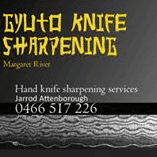
GYUTO KNIFE SHARPENING
Be diligent to keep your sharpening angle consistent along the whole length of the blade
[/quote]
[quote style=”boxed”]
HEIMERDINGER CUTLERY – FACEBOOK
My number one tip is to learn to hold a consistent and correct angle. It takes time and practice, but by doing that you can avoid having to buy any sharpening aids.
[/quote]
[quote style=”boxed”]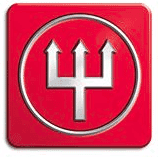
WÜSTHOF – FACEBOOK
There are a few ways customers can sharpen their knives, take a look at this.
[/quote]
[quote style=”boxed”]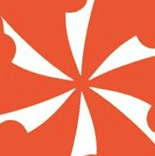
KNIFE CENTER – FACEBOOK
We recommend one of the kits with guide rods so there is no guess work involved. You can go with Lansky or GATCO.
[/quote]
[quote style=”boxed”]
SMITH’S CONSUMER PRODUCTS – FACEBOOK
Sharpen regularly. Regular sharpening may involve only fine-tuning the edge, but infrequent sharpening may require much more work to restore the edge. Sharpen the edge as soon as you notice it’s not working as well as it should. If you attend to the edge soon enough, it shouldn’t take much to bring the edge back to sharp.
[/quote]
[quote style=”boxed”]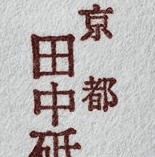
PRECISE SHARPENING
Become expert in using a 1000 grit stone first. Only then should you go to finer grits. Going to a finer grit without an excellent 1k edge will give you a shiny edge that cuts poorly.
[/quote]
[quote style=”boxed”]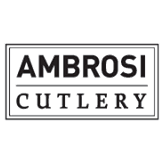
AMBROSI CUTLERY – FACEBOOK
It’s all about the angles!
[/quote]
[quote style=”boxed”]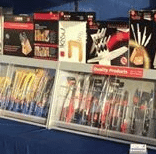
SLICE OF LIFE – FACEBOOK
Number 1 tip would be buy a good quality knife from a reputable manufacturer, cheap knives=poor steel quality and won’t give you a true indication of how your progressing.
[/quote]
[quote style=”boxed”]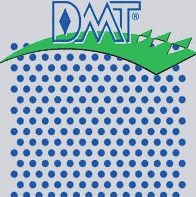
DMT – FACEBOOK
Number one tip would be- make sure you are sharpening the whole edge and maintaining the same angle all the way through. Best way to know this would be using a Sharpie (perm. marker). Color the area to be sharpened and when the marker is gone, you have successfully sharpened the edge. Happy sharpening!
[/quote]
[quote style=”boxed”]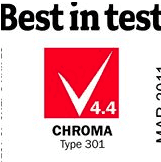
CHROMA CNIFE – FACEBOOK
Buy yourself a good stone! Better one knife less, but the best stone!
[/quote]
[quote style=”boxed”]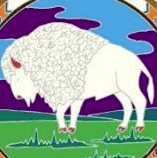
KNIFE AND TOOL SHARPENING
take your time, be proficient and careful.
[/quote]
[quote style=”boxed”]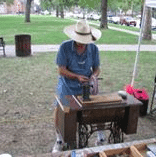
KEVIN NOON SHARPENING – FACEBOOK
As a professional knife sharpener, I pay attention to each knife as if I was going to take it home and use it. I make sure it is properly shaped and sharp before returning it to my customers.
[/quote]
[quote style=”boxed”]
MAKESUSHI – FACEBOOK
Practice first on an inexpensive knife several times to find your rhythm.
[/quote]
[quote style=”boxed”]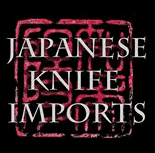
JAPANESE KNIFE IMPORTS – FACEBOOK
Use sharpie when sharpening. There are probably things one needs to know before even getting this far, but this is by far the thing that makes the biggest difference in beginner sharpeners’ sharpening. Heck, even skilled sharpeners benefit from this. You can also check this video.
[/quote]
[quote style=”boxed”]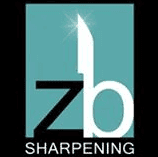
ZB SHARPENING – FACEBOOK
Understand the different edge geometries of knives first and foremost. Then you can make the correlation of what techniques or systems can achieve those edges. There is no “one size fits all” system, so starting out, use a system that can keep your edges properly sharp at the angle and style they were designed to be. Do not change the knife profile to fit the system.
[/quote]
[quote style=”boxed”]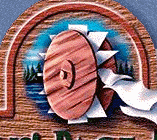
CASEYSPM
The number one tip is get a burr. Without the burr you will never get the knife sharp. Read this article too.
[/quote]
[quote style=”boxed”]
THE KNIFE GUY
Angle guide
[/quote]
[quote style=”boxed”]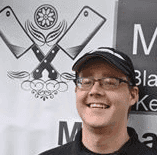
MAYNARD EDGE – FACEBOOK
#1 i suggest getting a guide like this one: make sure the guide matches your factory angle!
#2 also a decent wet stone like this one: a combination stone like the 120/1000 will work fantastic
#3 learn how to use a honing steel correctly (even long time chef’s don’t)
[/quote]
[quote style=”boxed”]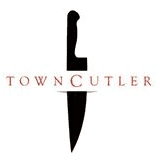
TOWN CUTLER – FACEBOOK
Keeping the angle consistent is key.
[/quote]
[quote style=”boxed”]
THE KNIFE DOCTOR – FACEBOOK
My number one tip? KEEP THE EDGE COOL. A knife is tempered at approx 200 degrees celsius …. not very hot … in fact you can temper knife blades in your oven at home. The biggest mistake “knife sharpeners” make is dry grinding on powered equipment. Sharpen by hand or use water-cooled equipment!
[/quote]
[quote style=”boxed”]
SHARP QUICK
I have an answer to your question and a piece of advise to those who want to have very sharp knives. To achieve the best edges you must sharpen at a constant and precise angle.
[/quote]
[quote style=”boxed”]
BRONKS KNIFE WORKS
The first thing that I usually tell newby sharpeners is not to try and dig a basement with a tea spoon. Simply put; Make burr with course stone and then remove burr with fine stone. The one biggest mistake for beginners is to use a super fine hone on a knife that is dull enough to ride clear to China, as we used to say. I remember some of my first experiences with trying to sharpen a hunting knife as a young lad. I would start at a proper sharpening angle and as I became impatient I would raise the angle higher and higher until I was actually making the edge worse. As long as you don’t raise the blade over 25 degrees and keep at it until you grind to the edge, you will get an edge, although 20 degrees is about right for average blade.
[/quote]
[quote style=”boxed”]
MCCALL CUTLERY
Don’t use mineral oil on the sharpening stone because it clogs it. I use water in a squirt bottle with a few drops of dish soap, like Dove. Afterwards, just wash off the sharpening stone and wrap it in a paper towel and let dry off over night.
[/quote]
[quote style=”boxed”]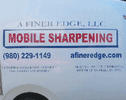
A FINER EDGE
Sharpen until you see a burr the entire length of the edge… no burr… no edge.
[/quote]
[quote style=”boxed”]
KNIFE HEAVEN – FACEBOOK
Start with a cheap knife and keep practicing.
[/quote]
[quote style=”boxed”]
BÖKER – FACEBOOK
For someone who just starts with knife sharpening we would recommend using a sharpener which supports him in holding the right angle. There are a couple of suitable solutions available, like the Spyderco Sharpmaker or the Work Sharp Knife and Tool Sharpener. Be careful with knife sharpeners with V-angled carbid-blades: while they do help to keep the right angle we do not recommended these sharpeners for high quality knifes.
[/quote]
[quote style=”boxed”]
KME SHARP
1) Sharpening is more about knowledge than it is about skill
2) and the most important piece of knowledge is to understand is that Sharpening requires a very coarse stone. Fine and X-fine grit stones can not sharpen a knife. They can only polish and refine the edge created by the coarse stones. Advancing to fine and extra-fine stones before the blade is made sharp by the coarse stone will result in a highly polished … dull blade.
[/quote]
[quote style=”boxed”]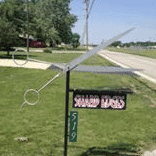
SHARP EDGES
Match the angle of sharpening to the knife and its use. For example a meat cleaver would not need to have an edge that would be razor sharp. The edge is designed for heavy use and a chopping motion, the edge if sharpened thin and razor sharp would not last and could be damaged easily.
A fillet knife however would need an edge that is very thin and razor sharp for its intended use.
[/quote]
[quote style=”boxed”]
EDGE PRO – FACEBOOK
For someone who is just getting started with our sharpening system, I’d recommend that you begin practicing on larger kitchen knives. Like an 8″ chef’s knife ideally. Sharpening with an Edge Pro takes most people about 15 minutes of practice before they begin to feel real comfortable. A larger knife is easier to hold, and will help you develop the coordination faster.
For someone who is freehand sharpening, first thing I’d recommend is to save yourself years of frustration and get an Edge Pro.
[/quote]
[quote style=”boxed”]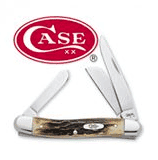
W.R. CASE – FACEBOOK
Choose your sharpening device according to where you plan to be when resharpening. You don’t want to be pulling out a benchtop stone while in the uplands hunting geese. And you don’t want to be using a handheld carbide stick-type sharpener at home when you could be using a stone.
[/quote]
[quote style=”boxed”]
SHARPENERS REPORT – FACEBOOK
Read Steve Bottorff book on “Sharpening Made Easy” for non professional knife sharpening. Read Sharpeners Report if you go into business. Youtube is ok, but TRAINING in person is best.
[/quote]
[quote style=”boxed”]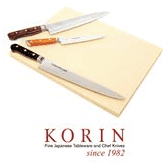
KORIN – FACEBOOK
Make sure your sharpening stone is completely flat when sharpening your knife!
[/quote]
[quote style=”boxed”]
BLADEHQ – FACEBOOK
It is very important to keep your angle right and have patience. Don’t get frustrated and chew the edge off your knife. As far as what product to use for starters, I would suggest the Spyderco Sharpmaker or the Work Sharp. If you’re going to get the Work Sharp, get the Ken Onion edition. It’s a bit more money but it’s so much nicer thus making the extra cash worth it.
[/quote]
[quote style=”boxed”]
DARREN BUSH
Maintenance is as important as sharpening. A little work on the front side saves a lot of grinding on the back side.
Read more here.
[/quote]
[quote style=”boxed”]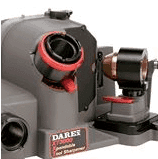
DAREX – FACEBOOK
Get yourself a Work Sharp Knife & Tool Sharpener and sharpen like a pro – literally.
[/quote]
[quote style=”boxed”]
STEFAN STEIGERWALD
For finest surfaces and nice geometry I take the “wicked edge”. For everything else a “Dianova” sharpener. Also check my book.
[/quote]
[quote style=”boxed”]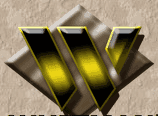
WHITMAN SHARPENING
Tip to professional knife sharpeners: Research your equipment you expect to purchase very well. Determine your field of potential expertise as there are many directions you can pursue in the sharpening endeavours. Return on investment and satisfaction of career choice are very important.
[/quote]
[quote style=”boxed”]
SPYDERCO – FACEBOOK
The best tip we could give someone who is just learning to sharpen a knife, is to maintain a consistent angle—no matter what sharpener you use. Obviously, the beauty of our Sharpmaker is that it does this for you and greatly reduces the skill necessary to sharpen a knife.
[/quote]
[quote style=”boxed”]
KNIFE OUTLET – FACEBOOK
Maintain a consistent bevel angle throughout the process, learn how to feel the burr and finish completely with each grit before going on to the next. Use the burr as a guide.
[/quote]
[quote style=”boxed”]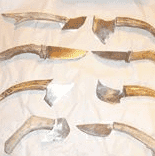
H & H KNIFE SHARPENING
Most important Number one thing to remember is :try and sharpen keeping the right degree angle on. Always keep the blade wiped down.
[/quote]
[quote style=”boxed”]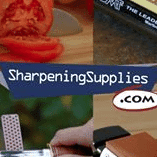
SHARPENING SUPPLIES – FACEBOOK
We work with beginning sharpeners on a daily basis. The most common mistake beginners tend to make is skipping the coarse grits and going straight to fine grits.
Fine grits sharpen many times slower than coarser girts. It is important to start with a fast sharpening coarse stone so they can see their results more quickly, and then refine the edge with finer grits.
We have found that beginners focus on the end result and overestimate the speed that a very fine stone can sharpen. The fine stones sharpen slowly and therefore give slower feedback. The inexperienced sharpener may mistake the lack of progress for a lack in technique. Coarse stones will make quick work of sharpening by dramatically cutting down on the number of strokes needed and reduce the overall sharpening time.
While beginners can make a number of mistakes, starting with too fine of a stone is easy to fix. Simply use a coarse stone with a grit between 200 and 400 before you move to finer grits. The finer grits should be used to refine an edge after it is coarsely sharpened.
[/quote]
[quote style=”boxed”]
KEITH MCCAFFERTY – FACEBOOK
I would advise buying a knife with
a reasonable Rockwell C hardness of 57-59, rather than a harder blade in the
60s range. Harder blades hold an edge longer, but when they lose it they
are more difficult to resharpen. Softer steel is much easier to sharpen.
For a hunter who is dressing out an elk, or for bushcraft work, it’s
important to able to reharpen a blade in the field. A simple small diamond
stone with a coarse and fine side works well for me. Read my article about sharpening here.[/quote]
What’s YOUR #1 Knife Sharpening Tip?
Let me know in the comments below!










